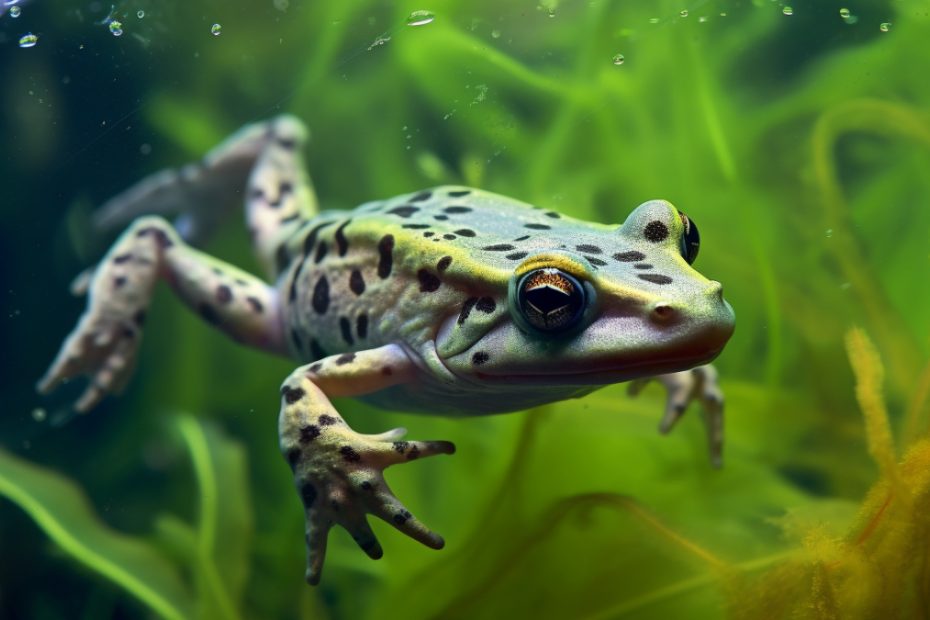More than 7,200 frog species are found in nature. These frogs can be divided into three main categories. The categories are aquatic, arboreal, and terrestrial. Some frogs can be semi-aquatic, but our focus today is on aquatic frogs only.
I will introduce you to 4 aquatic frogs: frogs that live in water throughout their lifespan. They are African Clawed Frog, Surinam Toad, Western Clawed Frog, and American Bull Frog. These frogs generally live in freshwater lakes, streams, or slow-moving water bodies like ponds.
Get to know some of the most popular aquatic frogs around the world, their habitats, characteristics, and other details.
What Are the Characteristics of Aquatic Frogs?
To be able to live completely in water, aquatic frogs have webbed feet that help them propel through water. Their legs are long and powerful for swimming easily. Some aquatic frogs can have claws.
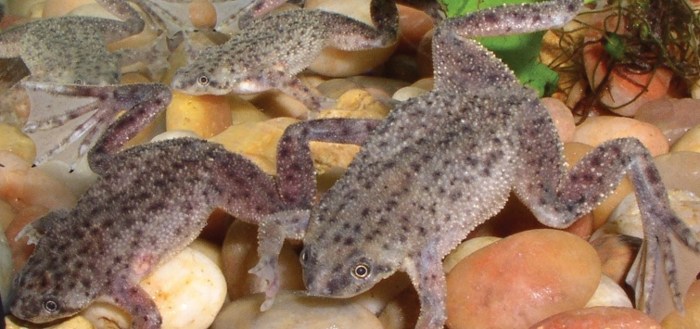
Most of the water frogs are distributed across the Andean in South America and the sub-Saharan region in Africa. These frogs are generally small and go through metamorphosis. Aquatic frogs or water frogs can have different types of skins, colors, and body shapes.
The lifespan and general characteristics of various aquatic frog species also differ noticeably. Let’s meet some of the most common aquatic frogs in the world.
4 Aquatic Frog Species: Appearance, Characteristics, Diet, and Habitat
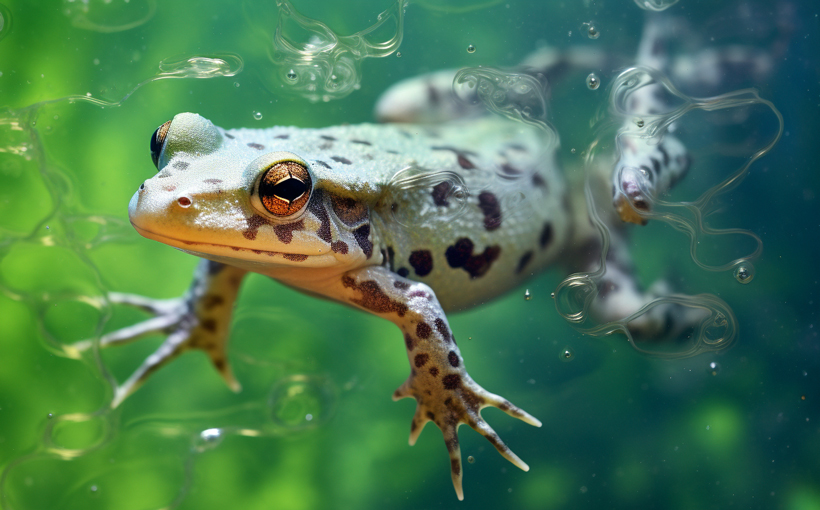
Many aquatic frog species are popular as aquarium pets. See how these aquatic frogs do in their natural habitats.
1. African Clawed Frog
The African clawed frog is native to the tropical regions in South America. You can also find them in sub-Saharan Africa where they share their habitats with many other water frogs from the same family.
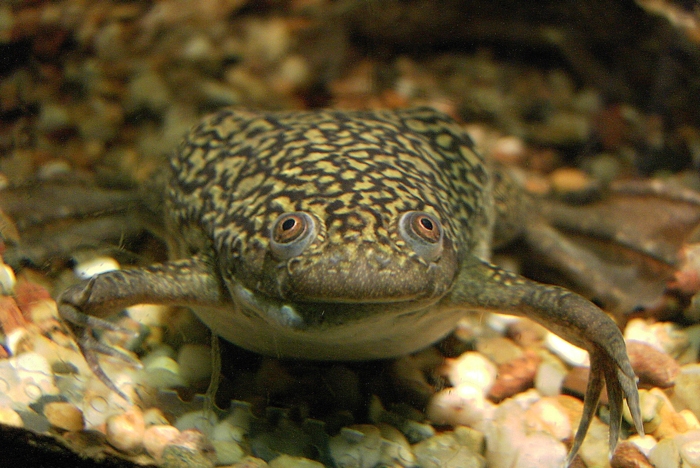
Classification
- Kingdom: Animalia
- Phylum: Chordata
- Class: Amphibia
- Order: Anura
- Family: Pipidae
- Genus: Xenopus
- Species: Xenopus laevis
Appearance
The first thing you will notice in African clawed frogs is their clawed toes. Their front feet have smaller webbings with larger claws. But the hind feet have bigger webbings for swimming in water. These frogs are usually brown or gray. But you may also find albino African clawed frogs.
African clawed frogs can be 1-5 inches long and weigh about 1-8 oz. They use their front feet to grab onto the prey and stuff it into their mouth. Their eyes are protruding from the head and positioned above the head. The same is true for the nose.
This helps them surface the eyes and the nose and submerge their bodies underwater to hide.
Habitat
You will find these frogs commonly in the southern and eastern parts of Africa. They live in stagnant water, mostly shallow creeks or river basins.
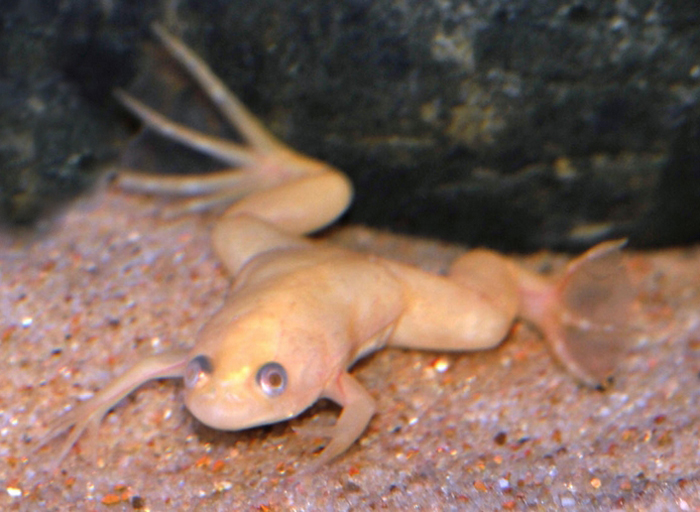
Characteristics
African clawed frogs are good swimmers and can swim at a speed of up to 5 miles per hour. They typically hunt their prey down with the sharp claws. The claws are also used to put the prey in their mouth.
These frogs generally spend their time at the bottom of the water bodies, which helps them find resources easily and stay away from predators.
Here is a video of African clawed frogs:
Diet
African clawed frogs usually eat water bugs, small fishes, insects, etc. But they can also eat their own skin. The frogs seem to eat their tadpoles too.
Mating and Lifespan
Female African clawed frogs lay eggs on the water surface. The average spawn size is 2000 and tadpoles are hatched in about five days. As they grow, their webbed feet and claws start to appear. African clawed frogs can live from five to fifteen years in the wild.
Conservation Status
According to the IUCN Red List, the African clawed frog has a status of Least Concern. It means the population of this species isn’t at risk. In fact, the population of African clawed frogs is increasing.
2. Surinam Toad
With an almost flat body, Surinam Toad is an interesting creature to watch. This ambush hunter is commonly found in Central America and South America.
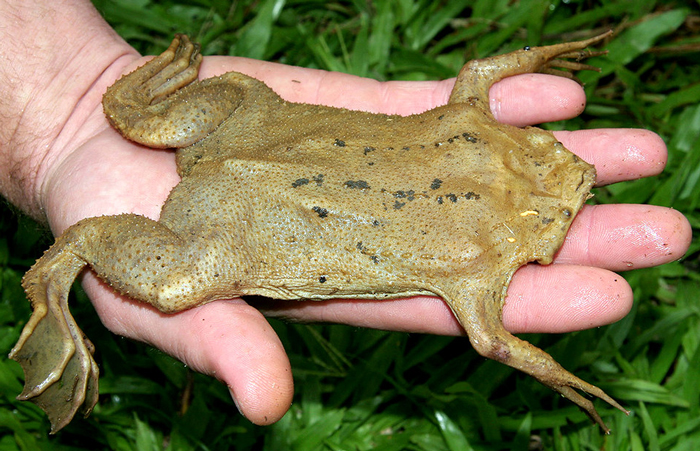
Classification
- Kingdom: Animalia
- Phylum: Chordata
- Class: Amphibia
- Order: Anura
- Family: Pipidae
- Genus: Pipa
- Species: Pipa pipa
Appearance
Surinam Toads are easily identifiable with their unique appearance. They have a boxy and flat body with a triangular head. Their snouts are quite long and the nostrils are located at the far end of the snout.
The skin of Surinam Toads is rough and pointy. They are usually mottled brown or olive. You may also see some having a tan skin. Their forelimbs have tiny tips that look like stars. These frogs are about 4-8 inches long and weigh about 3.5-5.6 oz.
Habitat
As I have already mentioned they are native to South America. You will commonly see these aquatic frogs in rainforest areas. They typically spend most of their time in muddy rivers where they can camouflage well.
Characteristics
Surinam Toads have a special characteristic of floating idle. This makes their predators confuse the toad for leaves or something else. With this maneuver, Surinam Toads also wait patiently for their prey to pass by.
These toads don’t have any teeth or tongues. They grab their prey with their star-shaped fingers and swallow it directly.
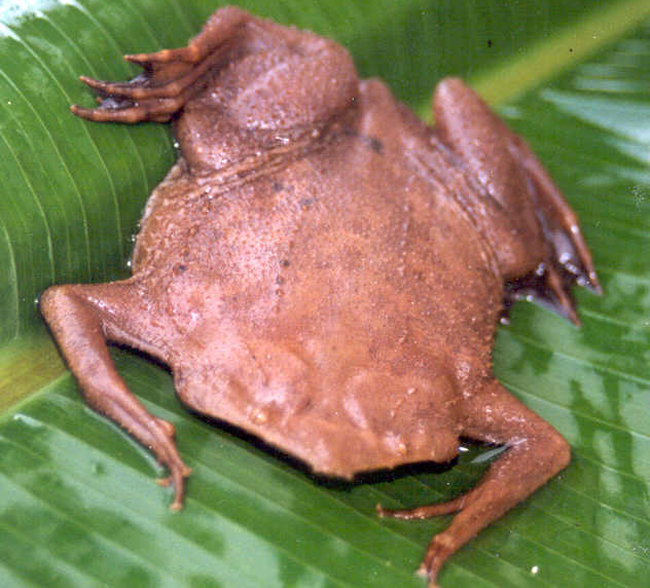
Diet
Surinam Toads are bottom-eaters. They live on mostly small fishes, insects, worms, etc. Crustaceans in the river beds are also their favorite.
Mating and Lifespan
These water frogs have a lifespan of about eight years in the world. Their mating is very unique and interesting. After fertilization, the eggs are attached to the back of female toads. When the tadpoles hatch, they tear the protective skin on the egg layer. It takes about eight to twelve weeks for the eggs to hatch.
Conservation Status
Like the African Clawed Frog, Surinam Toad is also listed as the Least Concern species on the IUCN Red List of Threatened Species.
3. Western Clawed Frog
This frog is also called the tropical clawed frog because of its natural distribution in the tropical and subtropical lowlands.
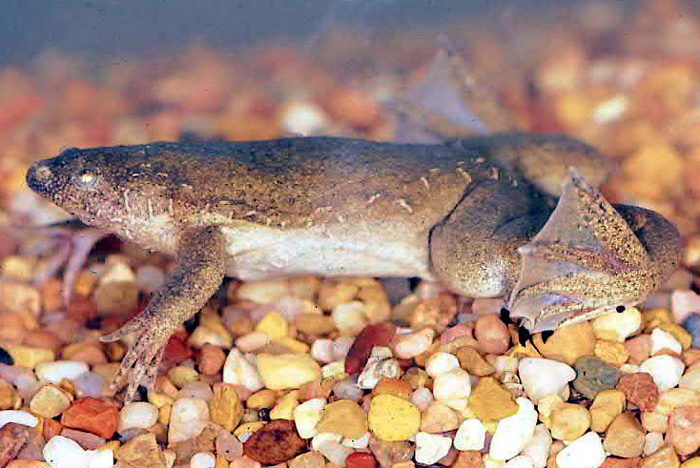
Classification
- Kingdom: Animalia
- Phylum: Chordata
- Class: Amphibia
- Order: Anura
- Family: Pipidae
- Genus: Xenopus
- Species: Xenopus tropicalis
Appearance
These small frogs are about 1.5 to 2 inches long. Female Western clawed frogs are larger. Their body is a bit flat with a long snout. Bulged eyes are positioned over the head so that they can easily see around while being submerged.
The forelimbs of these frogs are short and weak. But the hind legs are muscular with webbing in the feet. Most of the frogs have dark brown skin with grey or black spots. On the belly side, you may see pale white or yellow color with mottled brown.
Habitat
This frog commonly lives in rainforests, lowlands, and freshwater streams in South America and the Western Africa region. You will commonly find these frogs in Cameroon, Congo, Zaire, and Sudan.
Characteristics
Western clawed frogs usually live in shallow water bodies where they can have enough tree roots or holes to hide from their predators. In the rainy season, they tend to migrate to freshwater bodies.
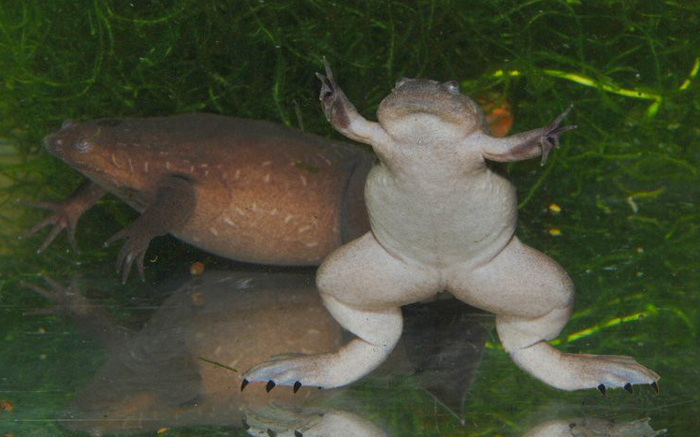
Diet
These frogs usually live on insects and small fishes. Worms and grubs are their favorite food. Often, they tend to eat tadpoles of other frog species living in the same area.
Mating and Lifespan
Western clawed frogs have a lifespan of about 5-8 years in the wild. But they can live much longer in captivity. Female frogs lay their eggs on tree leaves or roots where the eggs can be hatched.
Conservation Status
Like the previous two frog species, Western or Tropical clawed frogs are also listed as the Least Concern species on the IUCN Red List.
4. American Bull Frog
These frogs are vibrant and have spectacular characteristics.
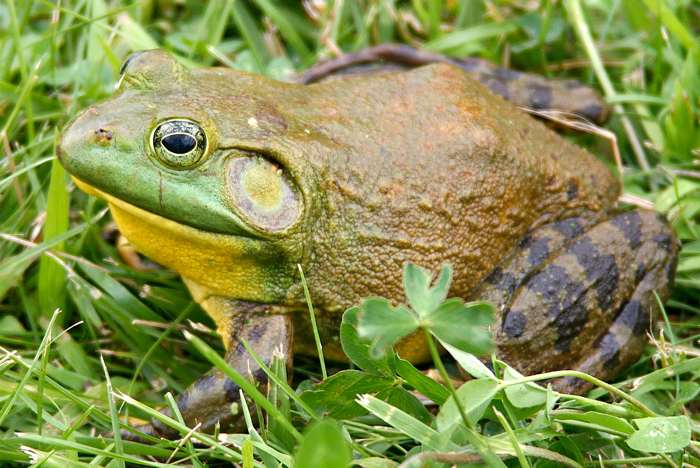
Classification
- Kingdom: Animalia
- Phylum: Chordata
- Class: Amphibia
- Order: Anura
- Family: Ranidae
- Genus: Lithobates
- Species: Lithobates castebeianus
Appearance
American bullfrogs are medium to large in size, measuring 3.6 to 6 inches in length. And they can weigh about 12 oz. These frogs have bright green or olive skin and can have dark spots in some places. Mottling or banding can also be present.
Their feet are slightly webbed, which helps them in swimming. Hind limbs are larger and more muscular than forelimbs. And the eyes are protruding from the head. The eardrums are easily visible.
Habitat
American bullfrogs are native to eastern North America. They prefer tropical or subtropical grasslands, swamps, freshwater lakes or marshes, ponds, etc. You may also find them in coastal areas.
Characteristics
These frogs can jump quite a distance with their strong hind legs. They usually spend most of their lifetime in water, only coming to the surface rarely.
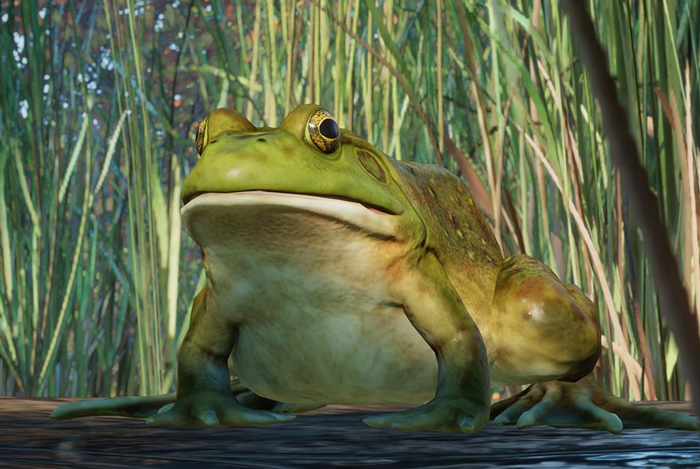
Diet
American bullfrogs are carnivores, so their primary diet is insects. They can also eat small fish, flies, etc., when available.
Mating and Lifespan
These frogs generally live about eight to ten years in the wild. Female frogs can lay about 25,000 eggs and it takes about ten weeks to hatch the eggs.
Conservation Status
According to the IUCN Red List, the American Bull Frog or Java frog is listed as the Least Concern species.
Exploring the diverse world of amphibians reveals many fascinating facts, especially when diving deep into the lives of aquatic frog species. These water-loving creatures are not only adaptively interesting but also play a role in some of the most intriguing events in nature. For example, ever heard of the phenomenon where it seems to be raining frogs? This odd occurrence has both baffled and amazed many. But frogs aren’t just about unique behaviors; they’re also a visual delight. Journey with us to the vibrant world of colorful frogs and be dazzled by the spectrum of hues they exhibit in the wild.FAQs
Check answers to some commonly asked questions about aquatic frogs.
Yes. Even though the aquatic frogs spend their lives in water, they breathe through their lungs. So, they are still amphibians, which is evident from their classifications.
Titicaca water frogs are the largest aquatic frog species in the world. They can be about 8 inches long, but these frogs aren’t native to America.
Like all other frog species, aquatic frogs are also cold-blooded. It means aquatic frogs can’t regulate their body temperature on their own.
Final Words
Aquatic frogs never fail to draw our attention with their distinct appearance, interesting characteristics, and wide distributions. Among many aquatic frogs, I dug up the details of 4 aquatic frogs: frogs that live in water.
The compilation will help you learn more about the scientific classification, appearance, habitat, diet pattern, mating behavior, and conservation status of these frogs. Get to know them and ensure a better natural habitat for these unique frogs.

Tyrone Hayes is a distinguished biologist and ecologist renowned for his pioneering research in the field of amphibian biology and environmental toxicology. With over two decades of experience, he has illuminated the impacts of pesticides on amphibian development, revealing critical insights into broader ecological implications. Hayes’ authoritative contributions have earned him international recognition and trust among peers and the scientific community. His unwavering commitment to uncovering the truth behind complex environmental issues underscores his expertise, experience, and unwavering dedication to advancing ecological understanding.
